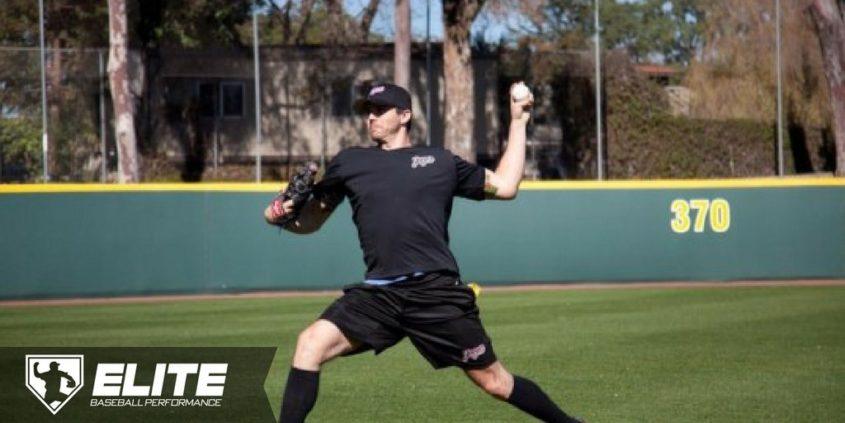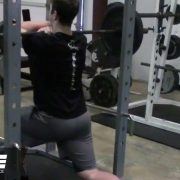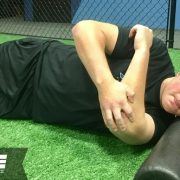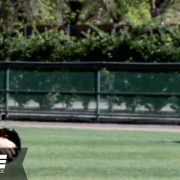Keys to an Inseason Throwing Program
A common concern we often hear at Elite Baseball Performance is pitchers not knowing what to do for an inseason throwing program. We recently discussed how to perform a throwing program to prepare for the season. If you’ve followed our recommendations and built a proper foundation of arm strength and endurance in the offseason, a correctly performed inseason throwing program will continue to facilitate a healthy arm.
Once the pitcher has built his pitch count leading into the season, I would assume that by the first game of the season, the pitcher is now in a position to throw 60-75 pitches or the equivalent of 4-5 innings, and 75-90 pitches by his second game. The key here is that the innings have been increased by maintaining a Long Toss program throughout the week. What has changed inseason is that the pitcher will learn to adjust the Long Toss program based on how many pitches they’ve made in a game, and how much recovery period they have until their next outing.
This is where inseason training gets a little tricky based on whether or not you are a starter or a reliever. So to address the inseason training mentality for both starters and relievers, I’m going to break them down into two categories. This way, whatever your role is as a pitcher you will have a clearer understanding of how to keep your arm in optimal shape throughout the year.
The following article will discuss how to develop an inseason throwing program. If you are interested in learning more, we an online version of our Thrive on Throwing 2 video where we show you exactly how to perform the Jaeger Throwing Programs, as well as a downloadable Year Round Throwing Manual that builds off this information and discusses how to best prepare your throwing programs throughout the year for optimal success. More information on these can be found below.
This article is part of a 3 part series on year round throwing:
- Part 1 – Building Your Offseason Baseball Throwing Program
- Part 2 – Preparing Your Arm for the Baseball Season
- Part 3 – Keys to a Baseball Inseason Throwing Program
Inseason Throwing Program for Starting Pitchers
While relievers have to play with unknown variables as to when and how much they are going to pitch from day to day, starting pitchers have it much easier inseason. Starting pitchers know exactly what day they are throwing each week and therefore can plan the other six days (amateur) or four days (professional) around their game day. For this reason, setting up a starter with an inseason routine is much easier than a reliever.
Below, I am going to go through the format and workload for a basic 7-day routine, considering that more players are at the amateur level. Also, once you understand the principles to the 7-Day routine, adjusting to the 5-Day routine will be relatively similar. Keep in mind that the priority is to always “listen to your arm.”
In Season Throwing Program – 7 Day Routine
To make this routine very simple to follow I’m going to pick “Monday” as the reference point as to when you are scheduled to start your game. By establishing our “game day,” we can then focus on how we maintenance (cycle) the arm back in shape most effectively for your next start, the following Monday.
Monday, Game Day (Long Toss Day)
Game day is ironically your best Long Toss day inseason because you’ve had six days to rest, recover and rebuild leading into your game day from your previous start.
As a simple example, if you have been long tossing out of season in the 250-foot range, then that’s about how far your arm is going to want to stretch out to the day of your start. In essence, your game day is very similar to your best offseason long toss day, except that you may cut down on the amount of throws you’re making in both the stretching out (going out away from your partner) and pull down phases of Long Toss (coming back toward your partner). If you feel like cutting a little distance out of your throwing (especially if it’s later in the season) or you feel like cutting down on your aggressive throws coming back in toward your throwing partner, that’s fine.
But if you conditioned your arm well throughout the off-season, your arm is going to want a pretty thorough long toss session the day of your start.
Tuesday, Day 1 after start (Recovery/Stretch)
Depending on how many pitches you made, Day 1 is all about blood flow, range of motion and “stretch throwing.” If you threw 90 pitches the day before you may only want to go out to 90-120 feet of really low impact, light catch. If you only threw 50 pitches, your arm may want a distance closer to 150-200 feet. Again, the priority is RECOVERY.
The focus is on positioning the arm for the next day, and in fact, the next start. There should be little to no “downhill” or aggressive throwing on Day 1.
Wednesday, Day 2 (Recovery/ Stretch)
Ironically, Day 2 is when most pitchers are the sorest after a start. Thus, Day 2 is often a continuation of the stretch out, low impact mentality. Again, keep in mind that your arm is going to tend to have a tremendous recovery in general due to your off-season throwing program, but to be safe, I tell players to let the arm breathe again on Day 2. Again, I would suggest minimizing downhill or aggressive throwing unless the arm tells you differently.
Thursday, Day 3 (Extension, Pull Downs)
Day 1 and 2 have now set you up for a more normal Long Toss session on Day 3. This is the beauty of having a 7-day routine — you can use an extra couple of days to recondition your arm inseason. The arm is positioned on Day 3 to both stretch out to it’s normal Long Toss distance and to pull down relatively aggressively. How far you go out again depends on the individual, but for someone who throws 85mph, your probably looking at about 250 feet. Harder throwers again are looking at 300 feet or more.
So we’re both extending the arm on Day 3, and we’re beginning to integrate the pull-down or aggressive phase of Long Toss. The key here is to still use Day 3 as a conditioning day and to prep for Day 4, which is your bullpen day.
Friday, Day 4 (Long Toss/BullPen)
Now that you’ve used the first three days after your start to do nothing but progressively and effectively build the arm back into shape you are now set up for your bullpen day. The key here is to not “save your arm” by minimizing your throwing before the bullpen.
It’s actually to do the opposite.
You have set your arm up for another great Long Toss day, and that is your priority. Again, your bullpen tops off your workout as opposed to being the focal point of it. It doesn’t mean that you have to have an epic Long Toss before your bullpen, it just means to be sure that you have a pretty thorough Long Toss before getting on the mound.
Remember, your arm is programmed now to condition before it gets on a mound, and that’s the way you want it to be.
Saturday, Day 5 (Stretching/Optional)
Day 5 is a bit like Day 1 after your start. You’ve been on the mound the day before, you’ve had a lot of workload leading up to this point in the week, so I advise pitchers to go lighter on Day 5.
Again, listen to your arm, but you may find that you are only interested in a minimal amount of throwing, or you may find that you want to stretch it out to 120-150 feet without any aggressive throwing, or you may want another good day of stretching the arm out pretty far. This day is dictated by how you feel and the timing within the season.
Listen to your arm.
Sunday, Day 6 (Stretching/Rest/Optional)
The day before any pitches start can truly be a personal preference. So, I always advise pitchers to do what’s comfortable. Some pitchers like to take the day off, some like to play light catch, and some like to stretch it out to about 75% of their max distance, but with little to no aggressive throwing downhill. It is the core principle of our program to listen to your arm, and this day is no different. Do what feels right.
Monday, Day 7, Game Day (Long Toss)
Now you can see how your “start day” is your best day to Long Toss. You’ve spent the previous six days resting, recovering and rebuilding in the most optimal and effective way. You’ve allowed the arm to progressively build itself back into shape and positioned it for what it wants most, a great Long Toss/conditioning session before getting on the mound.
Inseason Throwing Program for Relief Pitchers
Because relief pitchers don’t have a set rhythm throughout the season, it can be a little bit harder to figure out when to Long Toss and when to rest from outing to outing.
As you will find with our approach, “listening to your arm” is always the first principle to keep in mind because there are so many variables. For instance, you may have made 40 pitches in relief the previous day, or you may not have thrown in a game situation for a week. In either case, your plan should be to go out each day to do your arm care program and stretch your arm out.
This sensation of stretching your arm out is what I refer to as “opening the door,” meaning, you are allowing your arm to get the benefits of stretching, blood flow and range of motion each day, regardless of whether or not you are pitching that day. What you’ll begin to realize is the arm wants to stretch out every day (unless it needs a total rest), and that some days the arm will want to stretch out further than others. In fact, if a pitcher has gone more than 3-4 days without pitching in a game, the arm will probably want to not only “open the door” to a long distance, but it will want to come back in toward your throwing partner and “pull down” aggressively just like an ordinary offseason Long Toss session.
This feeling of wanting to “close the door” after some days off of the mound is essential in keeping your base strong throughout the season. Having an aggressive Long Toss session may be critical for your base even if you are going to pitch in the game later that night. Remember, the point is to “condition” first when the arm needs it. Besides, you will probably throw harder and have better recovery period even if you do get into the game on a night that you had a relatively aggressive Long Toss session.
In short, relief pitchers should come to the field each day to “open the door” or stretch out the arm. How far, how long and whether or not you “pull down” aggressively depends on how much throwing you’ve done the previous day or days. The key is to always go out with the intention of stretching your arm out because, quite simply, your arm has been built this way from the off-season and it is looking to condition, even in season.
Keys to an Inseason Throwing Program
Inseason throwing is just as important as throwing in the offseason. A proper inseason throwing program must build in both rest and recovery days, as well as long toss and pull down days. As always, the key is developing a program based on your role, starter or reliever, and most recent workload.
When in doubt, “listen to your arm.”
Learn the Jaeger Long Toss Program

We also have a more detailed Year Round Throwing Manual that builds off this article in much more detail and shows you exactly what to do for a throwing program throughout the entire year.
If you don’t have a structured throwing program that you follow, this is an essential place to start:
- Click here for more information on the online version of the Jaeger Thrive on Throwing 2 program
- Click here for more information on the downloadable Jaeger Year Round Throwing Manual
Alan Jaeger
Latest posts by Alan Jaeger (see all)
- Building Your Offseason Baseball Throwing Program - October 24, 2017
- A Daily Mental Practice for Baseball Players - September 12, 2017
- Keys to an Inseason Throwing Program - March 1, 2017










Leave a Reply
Want to join the discussion?Feel free to contribute!